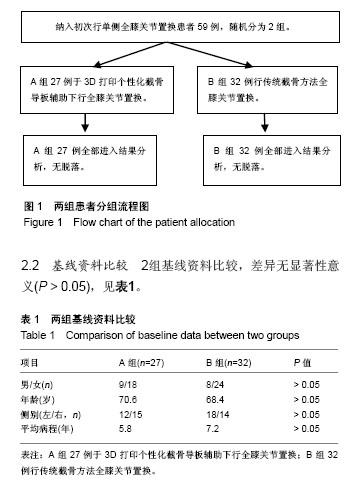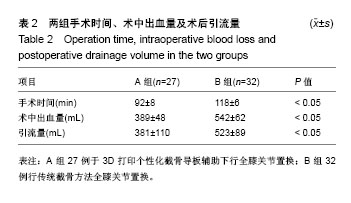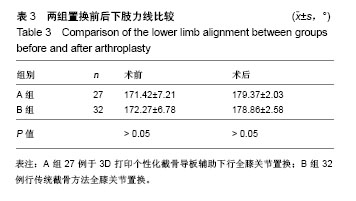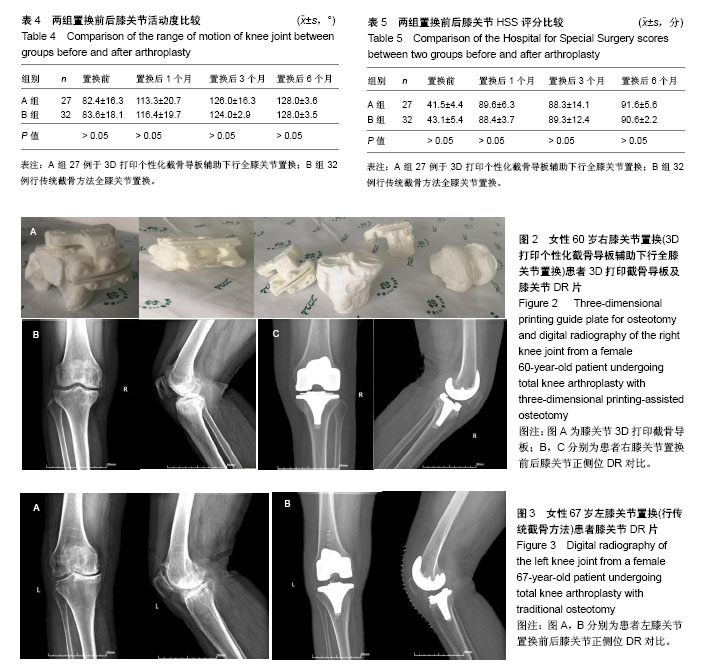| [1] Friederich N, Verdonk R. The use of computer-assisted orthopedic surgery for total knee replacement in daily practice: a survey among ESSKA/SGO-SSO members. Knee Surg Sports Traumatol Arthrosc. 2008;16(6):536-543.[2] ZIN Mar Aung,韩文卿,陈骁俊,等.基于三维打印技术的人工骨修复下颌骨缺损149例临床分析[J].上海交通大学学报(医学版), 2017,37(6): 759-763.[3] 黄轩,李凤宁,张帆,等.三维打印个体化导航模板在在枕骨髁螺钉固定技术中的应用研究[J].中国脊柱脊髓杂志, 2014,24(5):440-446.[4] 林越威,曾辉宇,刘啸宇,等.三维打印技术在人工器官生产上的应用[J].生物医学工程学杂志,2015,32(5):1160-1164.[5] Voleti PB,Hamula MJ,Baldwin KD,et al. Current data do not support routine use of patientspecific instrumentation in total knee arthroplasty. J Arthroplasty. 2014;29(9):1709-1712.[6] Thienpont E,Schwab PE,Fennema P. A systematic review and metaanalysis of patientspecific instrumentation for improving alignment of the components in total knee replacement. Bone Joint J. 2014;96-B(8):1052-1061.[7] 邹运,韩青,徐晓麟,等.3D打印光固化树脂模型在精准评估膝关节损伤及其个体化治疗方案制定中的应用[J].吉林大学学报(医学版), 2017,43(1):141-146.[8] 于晨曦,孙水.3D打印技术在髋、膝关节置换术中的应用进展[J].山东医药,2017,57(32):104-106.[9] 牛爱军,党新安,杨立军.快速成型技术的发展现状及其研究动向[J].热加工工艺,2008,37(5):116-118.[10] 鲍立杰,张志平,吴培斌.3D打印技术在骨科的研究及应用进展[J].中国矫形外科杂志,2015,23(4):325-327.[11] 孙凤龙,章耀华,李强,等.Deluxe-PS型与PFC Sigma RP型假体在膝关节置换中的比较[J].中国组织工程研究,2016,20(17):2459-2466.[12] 高升焘,万连平,张鹏,等.多尺寸人工全膝关节系统的临床应用分析及随访结果[J].中华关节外科杂志(电子版), 2013,7(6):775-779.[13] 卢耀甲,熊传芝,李小磊,等.减少人工膝关节置换失血:两种方法的比较[J].中国组织工程研究,2017,21(7):1004-1008.[14] 杨健齐,陈显辉,魏鲁青,等.屈膝位间断夹闭引流控制膝关节置换术后出血[J].中国矫形外科杂志,2017,25(7):596-600.[15] Raleigh E,Hing CB,Hanusiewicz AS,et al. Drain clamping in knee Arthroplasty,arand omized controlled trial. Aaz J Surg. 2007;77(5): 333-335.[16] 杨礼庆,马超,杜帅.人工膝关节置换术围手术期疼痛管理现状[J].中国矫形外科杂志,2017,25(3):247-250.[17] 张晨,班文瑞,马骏,等.多模式镇痛治疗人工全膝关节置换术后疼痛及非甾体类抗生素使用量的临床研究[J].中华关节外科杂志(电子版),2016,10(3): 281-286.[18] 李海涛,李昊儒,谢皓,等.规范化预防人工全膝关节置换术后静脉血栓栓塞症的有效性与安全性[J].临床合理用药,2017,10(12A):149-151.[19] 戴闽. 实用骨科治疗与康复[M]. 北京:人民卫生出版社,2007:374.[20] 黄小玲,唐金树,李岩,等.骨科康复一体化模式对全膝关节置换术后功能恢复影响的临床研究[J].中国康复医学杂志,2016,31(8): 868-873,898.[21] 朱诗白,翟洁,蒋超,等.膝关节置换围手术期的快速康复措施[J].中国组织工程研究,2017,21(3):456-463.[22] 夏克明,朱伟民.老年人工全髋关节置换术与全膝关节置换术后隐性失血的相关机制及输血策略[J].中国老年学杂志,2017,37(8):1954-1956.[23] Kalairajah Y, Sim Pson D, Cossey AJ, et al. Blood loss after total knee replacem ent:effects of com puter-assisted surgery.J Bone Joint Surg Br. 2005;87(11): 1480-1482.[24] Fahmy NR, Chandler HP, Danylchuk K, et al. Blood-gas and circulatory changes during total knee replacement. Role of the intramedullary alignment rod. J Bone Joint Surg Am. 1990;72(1): 19-26.[25] Gleitz M,Hopf T,Hess T. Experimental studies on the role of intramedullary alignment rods in the etiology of fat embolisms in knee endoprostheses. Z Orthop Ihre Grenzgeb.1996;134(3): 254-259.[26] Choong PF, Dowsey MM, Stoney JD. Does accurate anatomical alignment result in better function and quality of life? Comparing conventional and computer-assisted total knee arthroplasty. J Arthroplasty. 2009;24(4): 560-569.[27] Sikorski JM. Alignment in total knee replacement. J Bone Joint Surg(Br). 2008;90(9):1121-1127.[28] Cinotti G,Sessa P,D’Arino A,et al. Improving tibial component alignment in total knee arthroplasty. Knee Surg Sports Traumatol Arthrosc. 2014[Epub ahead of print].[29] Abdel MP,Oussedik S,Parratte S,et al. Coronal alignment in total knee replacement: historical review,contemporary analysis,and future direction. Bone Joint J. 2014;96-B(7):857-862.[30] Pfitzner T,von Roth P,Perka C,et al. Intramedullary control of distal femoral resection results in precise coronal alignment in TKA. Arch Orthop Trauma Surg. 2014;134(4):459-465.[31] Sharkey PF,Lichstein PM,Shen C,et al. Why are total knee arthroplasties failing today-has anything changed after 10 years? J Arthroplasty. 2014;29(9):1774-1778.[32] 聂志刚,彭昊.全膝关节置换术后僵硬/不稳的原因及处理[J].中国矫形外科杂志,2015,23(23):2167-2170.[33] 吴博,王岩,张国强,等.两种股骨截骨角度对膝关节置换术中股骨假体冠状位对线的影响[J].中国矫形外科杂志,2017,25(9):838-843.[34] 牛鸣,马飞,马菊蓉,等.基于3D打印的个性化截骨技术与传统方式行全膝关节表面置换的临床对比[J].南方医科大学学报. 2017,37(11): 1467-1475.[35] 唐杞衡,周一新,尹星华,等.人工膝关节置换术后严重内科并发症分析[J].中国矫形外科杂志, 2015,23(21):1952-1954.[36] Cheng T, Zhang G, Zhang X. Clinical and radiographic outcomes of imagebased computer assisted total knee arthroplasty: an evidencebased evaluation. Surg Innov. 2011;18(1): 15-20. |
.jpg)




.jpg)